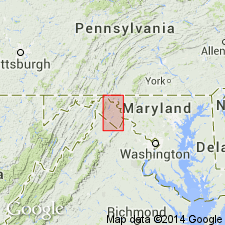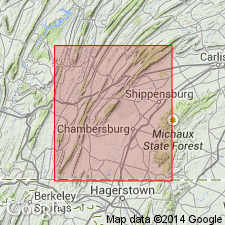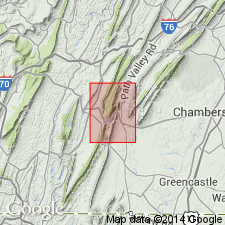
- Usage in publication:
-
- Row Park limestone*
- Modifications:
-
- Named
- Dominant lithology:
-
- Limestone
- AAPG geologic province:
-
- Appalachian basin
Summary:
Named Row Park limestone named for Row Park, Washington, Co., MD. Proposed for beds forming lower formation of St. Paul group. Typical Row Park contains four limestone types: (1) calcarenite, formed of pebbles and sand of limestone and dolomite in light crystalline matrix; (2) dove vaughanite, usually containing some white crystalline calcite; (3) granular limestone that varies in color from almost white to dark gray; and (4) dolomitic limestone. The thickness at the type locality is 162 feet. It underlies the New Market limestone and overlies Beekmantown dolomite. Base of Row Park cannot be traced along a line that corresponds exactly to a bedding plane in either underlying Beekmantown or to one within itself; beds or lenses of dolomitic limestone are interbedded with nonmagnesian limestone through a zone as much as 50 feet thick; the thickest variable zone corresponds to thickest Row Park section, and this zone thins as formation thins to south. Where Row Park is thickest, southwest of Marion and Welsh Run, PA, limestones are interbedded with the Beekmantown 40 to 50 feet below the stratum thought to represent base of Row Park.
Source: GNU records (USGS DDS-6; Reston GNULEX).

- Usage in publication:
-
- Row Park limestone
- Modifications:
-
- Revised
- AAPG geologic province:
-
- Appalachian basin
Summary:
Subdivided Row Park limestone into a lower Social Island limestone and upper Browns Mills limestone members.
Source: GNU records (USGS DDS-6; Reston GNULEX).

- Usage in publication:
-
- Row Park Formation
- Modifications:
-
- Revised
- AAPG geologic province:
-
- Appalachian basin
Summary:
Revised Row Park to Row Park Formation of the St. Paul Group in Pennsylvania. Publication includes 12 measured sections.
Source: GNU records (USGS DDS-6; Reston GNULEX).
For more information, please contact Nancy Stamm, Geologic Names Committee Secretary.
Asterisk (*) indicates published by U.S. Geological Survey authors.
"No current usage" (†) implies that a name has been abandoned or has fallen into disuse. Former usage and, if known, replacement name given in parentheses ( ).
Slash (/) indicates name conflicts with nomenclatural guidelines (CSN, 1933; ACSN, 1961, 1970; NACSN, 1983, 2005, 2021). May be explained within brackets ([ ]).

